Hiidenlegacysolutions
On this page, you find all documents, package deals, and flashcards offered by seller hiidenlegacysolutions.
- 19
- 0
- 0
Community
- Followers
- Following
19 items
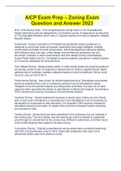
AICP Exam Prep – Zoning Exam Question and Answer 2023
NYC 1916 Zoning Code - First comprehensive zoning code in U.S. Had setbacks, height restricitons and use designations. Cumulative zoning. A response to construction of 'The Equitable Building' which cast a 7-square shadow and had no setbacks. Edward Bassett helped. Smartcode - Design charrette to ID Pedestrians standards, design guidelines. Is designed to avoid strip malls and sprawl, essentially encourage walkable, liveable communities and allow for land conservation. Aland development ord...
- Exam (elaborations)
- • 2 pages •
NYC 1916 Zoning Code - First comprehensive zoning code in U.S. Had setbacks, height restricitons and use designations. Cumulative zoning. A response to construction of 'The Equitable Building' which cast a 7-square shadow and had no setbacks. Edward Bassett helped. Smartcode - Design charrette to ID Pedestrians standards, design guidelines. Is designed to avoid strip malls and sprawl, essentially encourage walkable, liveable communities and allow for land conservation. Aland development ord...

2. AICP Exam - Fundamental Planning Knowledge (Theory) Exam Question and Answer 2023
Synoptic Rationality - theory in which the structured process of decision-making seeks to maximize the achievement of desired goals by careful consideration of potential consequences of alternatives; uses scientific method Wicked Problem - problem that is difficult or impossible to solve because of incomplete, contradictory or changing requirements that are difficult to recognize Incremental Planning - theory where planning is less of a scientific technique and more of a mixture of intuiti...
- Exam (elaborations)
- • 2 pages •
Synoptic Rationality - theory in which the structured process of decision-making seeks to maximize the achievement of desired goals by careful consideration of potential consequences of alternatives; uses scientific method Wicked Problem - problem that is difficult or impossible to solve because of incomplete, contradictory or changing requirements that are difficult to recognize Incremental Planning - theory where planning is less of a scientific technique and more of a mixture of intuiti...
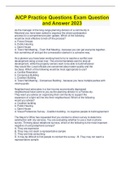
AICP Practice Questions Exam Question and Answer 2023
As the manager of the long-range planning division of a community in Maryland you have been asked to organize the citizen participation process for a comprehensive plan update. Which of the following would be most effective to kick off the process? a. Focus Groups b. Public Hearing c. Open House d. Town Hall Meeting - Town Hall Meeting - because you can get everyone together, kick something off and get the conversation started in a cohesive way. As a planner you have been working hard ...
- Exam (elaborations)
- • 30 pages •
As the manager of the long-range planning division of a community in Maryland you have been asked to organize the citizen participation process for a comprehensive plan update. Which of the following would be most effective to kick off the process? a. Focus Groups b. Public Hearing c. Open House d. Town Hall Meeting - Town Hall Meeting - because you can get everyone together, kick something off and get the conversation started in a cohesive way. As a planner you have been working hard ...
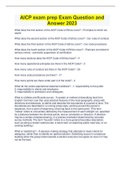
AICP Exam Prep - Theories/Movements Exam Question and Answer
Ladder of Participation - Sherry Arnstein, Bottom of ladder {non participation - Manipulation, Therapy.} Middle of ladder {Degrees of Tokensim - Informing, Consultation, Placation} Top of ladder {Degrees of Citizen Power - Partnership, Delegated Power, Citizen Control} Types of Planning Theory - 1. Theories of Urban Development (how cities grow). 2. Theories of Planning Practice (How planners perform their work). Theories of Urban Development - Patterns within a city {Concentric Circle,...
- Exam (elaborations)
- • 11 pages •
Ladder of Participation - Sherry Arnstein, Bottom of ladder {non participation - Manipulation, Therapy.} Middle of ladder {Degrees of Tokensim - Informing, Consultation, Placation} Top of ladder {Degrees of Citizen Power - Partnership, Delegated Power, Citizen Control} Types of Planning Theory - 1. Theories of Urban Development (how cities grow). 2. Theories of Planning Practice (How planners perform their work). Theories of Urban Development - Patterns within a city {Concentric Circle,...
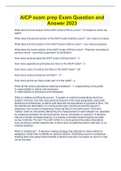
AICP exam prep Exam Question and Answer 2023
What does the first section of the AICP Code of Ethics cover? - Principles to which we aspire What does the second section of the AICP Code of Ethics cover? - Our rules of conduct What does the third section of the AICP Code of Ethics cover? - Our code procedures What does the fourth section of the AICP Code of Ethics cover? - Planners convicted of serious crimes - automatic suspension of certification How many sections does the AICP Code of Ethics have? - 4 How many aspirational ...
- Exam (elaborations)
- • 11 pages •
What does the first section of the AICP Code of Ethics cover? - Principles to which we aspire What does the second section of the AICP Code of Ethics cover? - Our rules of conduct What does the third section of the AICP Code of Ethics cover? - Our code procedures What does the fourth section of the AICP Code of Ethics cover? - Planners convicted of serious crimes - automatic suspension of certification How many sections does the AICP Code of Ethics have? - 4 How many aspirational ...
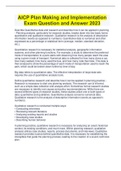
AICP Plan Making and Implementation Exam Question and Answer 2023
Describe Quantitative data and research and describe how it can be applied in planning - Planning analysis, particularly for research studies, breaks down into two basic forms: quantitative and qualitative research. Qualitative research is the analysis of descriptive information (words as opposed to numbers). Quantitative data is numerical and often expressed as a percentage or statistical term (average, median, standard deviation, etc.). Quantitative research is necessary for statistical ana...
- Exam (elaborations)
- • 7 pages •
Describe Quantitative data and research and describe how it can be applied in planning - Planning analysis, particularly for research studies, breaks down into two basic forms: quantitative and qualitative research. Qualitative research is the analysis of descriptive information (words as opposed to numbers). Quantitative data is numerical and often expressed as a percentage or statistical term (average, median, standard deviation, etc.). Quantitative research is necessary for statistical ana...

AICP: Plan Making and Implementation Exam Question and Answer 2023
The plan making process includes - Goals and visions; Analysis of current problems; and Creation of alternatives. What is strategic planning used for? - to assist an organization in guiding its future. Strategic planning sets goals, objectives, and policies for reaching the set objectives. Major questions a strategic plan should address - - What is the current situation and how is that situation likely to change in the foreseeable future? - Where are we going as an organization? - Ho...
- Exam (elaborations)
- • 18 pages •
The plan making process includes - Goals and visions; Analysis of current problems; and Creation of alternatives. What is strategic planning used for? - to assist an organization in guiding its future. Strategic planning sets goals, objectives, and policies for reaching the set objectives. Major questions a strategic plan should address - - What is the current situation and how is that situation likely to change in the foreseeable future? - Where are we going as an organization? - Ho...
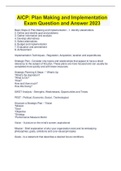
AICP: Plan Making and Implementation Exam Question and Answer 2023
Basic Steps of Plan-Making and Implementation - 1. Identify stakeholders 2. Define and identify goal and problems 3. Gather information and analysis 4. Develop alternatives 5. Select alternatives 6. Budget and implementation 7. Evaluation and amendment 8. Achievement Implementation Techniques - Regulation, Acquisition, taxation and expenditures. Strategic Plan - Consider only topics and relationships that appear to have a direct relevancy to the subject of the plan. These plan...
- Exam (elaborations)
- • 2 pages •
Basic Steps of Plan-Making and Implementation - 1. Identify stakeholders 2. Define and identify goal and problems 3. Gather information and analysis 4. Develop alternatives 5. Select alternatives 6. Budget and implementation 7. Evaluation and amendment 8. Achievement Implementation Techniques - Regulation, Acquisition, taxation and expenditures. Strategic Plan - Consider only topics and relationships that appear to have a direct relevancy to the subject of the plan. These plan...
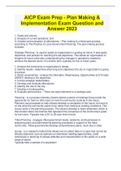
AICP Exam Prep - Plan Making & Implementation Exam Question and Answer 2023
1. Goals and visions; 2. Analysis of current problems; and 3. Creation and evaluation of alternatives. - Plan making is a three-part process, according to The Practice of Local Government Planning. The plan making process includes: Strategic Planning - is used to assist an organization in guiding its future. It sets goals, objectives, and policies for reaching the set objectives. This allows an organization to imagine its future while also understanding the changes in operations needed to a...
- Exam (elaborations)
- • 12 pages •
1. Goals and visions; 2. Analysis of current problems; and 3. Creation and evaluation of alternatives. - Plan making is a three-part process, according to The Practice of Local Government Planning. The plan making process includes: Strategic Planning - is used to assist an organization in guiding its future. It sets goals, objectives, and policies for reaching the set objectives. This allows an organization to imagine its future while also understanding the changes in operations needed to a...
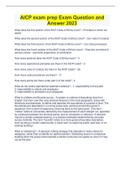
AICP Exam Prep 3.0 Exam Question and Answer 2023
1. The Disaster Mitigation Act of 2000 required local governments to address potential hazards in a Hazard Mitigation Plan in order to remain eligible to receive certain federal funds before and following federally-declared disasters. Your community has integrated such a plan into the General Plan. Now the Safety Element of the General Plan is expanded to cover the following: I. Natural hazards II. Man-made hazards III. Fiscal responsibility for disasters IV. A development retreat from low-lying...
- Exam (elaborations)
- • 11 pages •
1. The Disaster Mitigation Act of 2000 required local governments to address potential hazards in a Hazard Mitigation Plan in order to remain eligible to receive certain federal funds before and following federally-declared disasters. Your community has integrated such a plan into the General Plan. Now the Safety Element of the General Plan is expanded to cover the following: I. Natural hazards II. Man-made hazards III. Fiscal responsibility for disasters IV. A development retreat from low-lying...
